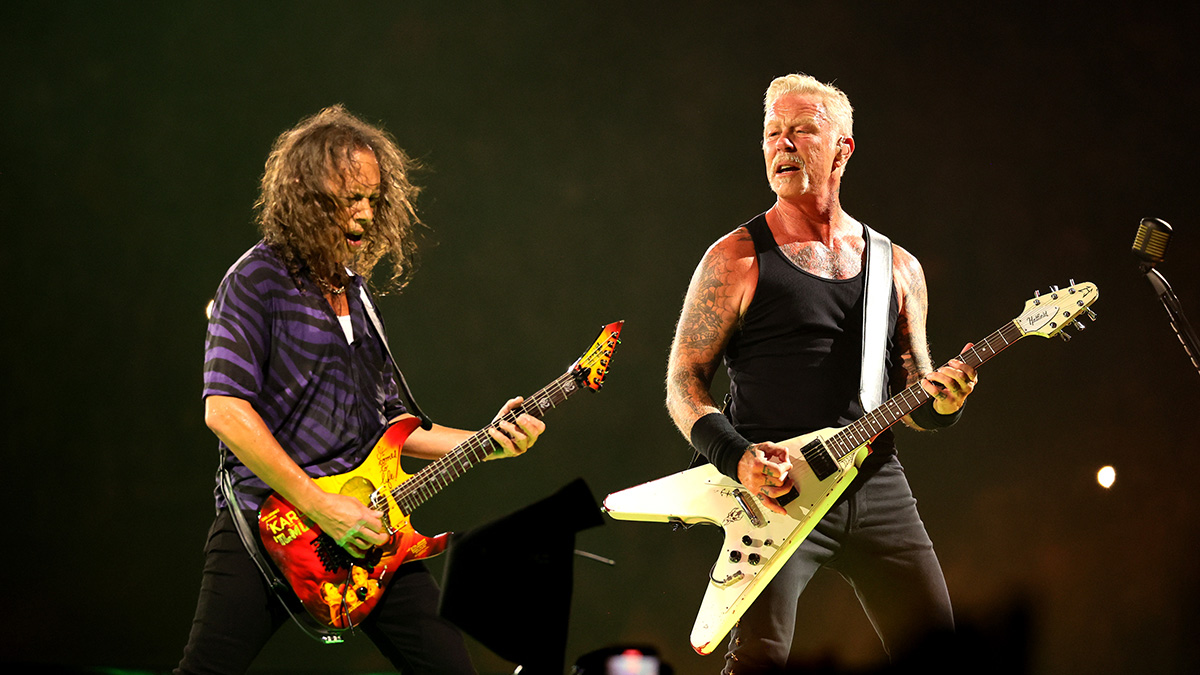“If you have too much distortion it feels like a sponge”: Kirk Hammett reveals the secret behind his Metallica rhythm tone and advises against high-gain overkill
Save the distortion pedals for the solos and keep that rhythm tone “harmonically tight”

The Metallica rhythm guitar sound is a reference quality electric guitar tone for generations of aspiring metal guitar players who have cranked up and down-picked in the hope of nailing James Hetfield and Kirk Hammett’s signature style.
There is a temptation to find a high-gain distortion pedal to help your amp along but Hammett himself would argue against it, and in conversation with Rick Beato, he has explained how the secret to his – and Hetfield’s – uncompromising rhythm tone is to use less gain, not more.
Not everyone agrees, he says, but Hammett has sound rationale for showing a little restraint.
“My rhythm sound it is a lot cleaner than you think,” he said. “Greg Fidelman [producer, Metallica’s 72 Seasons] is always pushing me to just add more distortion but I only like a distorted rhythm sound to an extent, because I need that punch. I need to feel like the strings are hitting [me]. I need to hear every single string when I hit a chord, and I need to like one note and you can feel it.”
There is a risk there, of course. That clarity comes with an obligation to play the part right, and not just to play it right but to perform it, to give it enough oomph to make it work.
The alternative, says Hammett, is dialing up the gain and then you lose the definition and, ultimately, the riff loses its punch.
“If you have too much distortion it feels like a sponge, it’s spongey,” he said. “I need [punch]. I need bark. I need to hit it. I need it so when I go ‘doonk!’ you physically feel it, and James is the same way. And it has always been that way. It has always been that way for him, and it has always been that way for me.”
Want all the hottest music and gear news, reviews, deals, features and more, direct to your inbox? Sign up here.
Speaking to MusicRadar in 2016, James Hetfield said he and Hammett were always searching for that “bark”. He described it as an ever-evolving process, a never-ending quest for Holy Grail tones in which the secret is in the midrange.
“For me it’s got to be percussive,” said Hetfield. “It’s got to push air, what we call bark. It’s got to bark. But I don’t want it really abrasive, so any fake fuzz to me really just takes away from the sound.
“And it’s tough because when you turn guitar sounds down, you really hear what they sound like and when you push them up it sounds a different way. So we’re trying to find that balance of enough mid push while still sounding big and what I’ve found is the wider and bigger you make it sound the thinner it becomes in a way, at least depth-wise.”
Hammett shared a few more insights into his signature tone in his conversation with Beato. He detailed the evolution of Metallica’s sound, from the modded Marshall that gave Kill ‘Em All its aggro crunch, to the Mesa/Boogie Mk II C+ – then state-of-the-art tube amps that would become the cornerstone of the band’s sound from Master Of Puppets to now.
This is an amp that has become the stuff of legend, most recently in the news when Neural DSP captured the Mk II C+’s uncompromising sound and considerable tone-shaping capabilities in a VST guitar plugin.
Hammett recalls visiting Mesa/Boogie with Hetfield in tow, getting a two-for-one deal on them and then taking them on tour in support of Ride The Lightning, learning how to dial them onstage, and setting the scene for that Master Of Puppets rhythm crunch.
“It was what we wanted, what we needed at the time, and that was the amps that we took into the studio from 1985 to now,” Hammett said. “We’re still using them.”
What you won’t find Hammett using is reverb or delay. The wah pedal is an ever present. There will always be a Tube Screamer on his pedalboard – just for the leads “because the gain needs to be tight, harmonically tight”. Delay pedals, though? No, too easy, and it feels wrong.
I need it so when I go ‘doonk!’ you physically feel it, and James is the same way
“I am not much for delay, or reverb,” he said. “Some of my favourite guitar players always have delay on, like Neal Schon always has his delay on. I love Neal Schon. One day I went and started playing, [though] my amp. and then adding a little delay, and I thought, ‘I like playing with delay but it kind of makes it easier. [Laughs] And I thought, ‘I’m not going to play with delay anymore.’ Y’know, there’s something about the note just hitting me. It feels like when there’s delay it’s going away from me, and, yeah, to certain extent it is.”
You can check out the full conversation above, and subscribe to Rick Beato’s YouTube Channel here.
Metallica are on tour right now, taking their “no repeats” M72 World Tour across the US right now. Tonight (18 Aug) they are in Arlington, Texas at the AT&T Stadium, and will be back again in a couple of nights for a second – and completely different set. See Metallica for tickets details and more dates.
Jonathan Horsley has been writing about guitars and guitar culture since 2005, playing them since 1990, and regularly contributes to MusicRadar, Total Guitar and Guitar World. He uses Jazz III nylon picks, 10s during the week, 9s at the weekend, and shamefully still struggles with rhythm figure one of Van Halen’s Panama.
